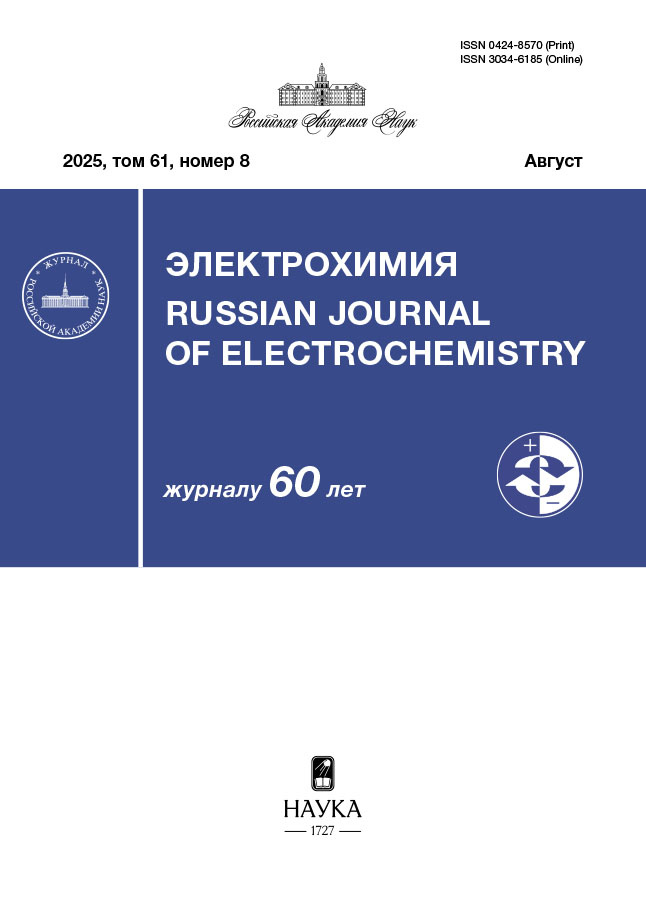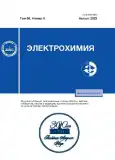Особенности влияния халькогенидов серебра на температуру размягчения халькогенидных стекол с ионной проводимостью
- Авторы: Тверьянович Ю.С.1, Фазлетдинов Т.Р.1, Томаев В.В.2,3
-
Учреждения:
- Санкт-Петербургский государственный университет
- Санкт-Петербургский технологический институт (технический университет)
- Санкт-Петербургский горный университет
- Выпуск: Том 59, № 8 (2023)
- Страницы: 442-447
- Раздел: Статьи
- URL: https://journal-vniispk.ru/0424-8570/article/view/139297
- DOI: https://doi.org/10.31857/S042485702308008X
- EDN: https://elibrary.ru/XYELBG
- ID: 139297
Цитировать
Полный текст
Аннотация
Приведен анализ изменения температуры размягчения халькогенидных стекол с ионной проводимостью по серебру от содержания его халькогенидов. Предложено объяснение особенностей изменения температуры размягчения стекол на основе халькогенидов серебра сосуществованием ковалентных связей серебро–халькоген (Ag–Ch) и металлофильных связей серебро–серебро (Ag–Ag). Большое количество рассмотренных систем демонстрирует общую закономерность, позволяющую считать, что степень связности серебра в сетке ХГС в силу формирования им помимо ковалентных металлофильных связей действительно существенно превосходит его формальную степень окисления. Предполагается, что металлофильные взаимодействия оказывают влияние не только на температуру размягчения, но и на изменение многих других важных свойств в указанных стеклах, включая механизм ионного переноса по серебру.
Об авторах
Ю. С. Тверьянович
Санкт-Петербургский государственный университет
Email: tvaza@mail.ru
Россия, 198504, Санкт-Петербург, Университетский просп., 26
Т. Р. Фазлетдинов
Санкт-Петербургский государственный университет
Email: tvaza@mail.ru
Россия, 198504, Санкт-Петербург, Университетский просп., 26
В. В. Томаев
Санкт-Петербургский технологический институт (технический университет); Санкт-Петербургский горный университет
Автор, ответственный за переписку.
Email: tvaza@mail.ru
Россия, 190013, Санкт-Петербург, Московский просп., 26; Россия, 199106, Санкт-Петербург, 21-я линия В.О., 2
Список литературы
- Salmon, P.S., Xin, S., and Fischer, H.E., Structure of the glassy fast-ion conductor AgPS3 by neutron diffraction, Phys. Rev. B, 1998, vol. 58, no. 10, p. 6115.
- Zeidler, A., Salmon, P.S., Whittaker, D.A.J., Piarristeguy, A., Pradel, A., Fischer, H.E., Benmore, C.J., and Gulbiten, O., Structure of semiconducting versus fast-ion conducting glasses in the Ag–Ge–Se system, R. Soc. Open Sci., 2018, vol. 5, p. 171401.
- Bychkov, E., Price, D.L., Benmore, C.J., and Hannon, A.C., Ion Transport Regimes in Chalcogenide and Chalcohalide Glasses: From the Host to the Cation-Related Network Connectivity, Solid State Ionics, 2002, vol. 154–155, p. 349.
- Bokova, M., Alekseev, I., and Bychkov, E., Mixed Cation Effect in Ag2S–Tl2S–GeS–GeS2 Glasses: Conductivity and Tracer Diffusion Studies, Solid State Ionics, 2015, vol. 273, p. 55.
- Shi, X., Chen, H., Hao, F., Liu, R., Wang, T., Qiu, P., Burkhardt U., Grin Y., and Chen, L., Room-temperature ductile inorganic semiconductor, Nat. Mater., 2018, vol. 17. p. 421.
- Tveryanovich, Y.S., Fazletdinov, T.R., Tverjanovich, A.S., Fadin, Y.A., and Nikolskii, A.B., Features of Chemical Interactions in Silver Chalcogenides Responsible for Their High Plasticity, Russ. J. Gen. Chem., 2020, vol. 90, no. 11, p. 2203.
- Evarestov, R.A., Panin, A.I., and Tverjanovich, Y.S., Argentophillic Interactions in Argentum Chalcogenides: First Principles Calculations and Topological Analysis of Electron Density, J. Comput. Chem., 2021, vol. 42, no. 4, p. 242.
- Tveryanovich, Yu.S., Fazletdinov, T.R., Tverjanovich, A.S., Pankin, D.V., Smirnov, E.V., Tolochko, O.V., Panov, M.S., Churbanov, M.F., Skripachev, I.V., and Shevelko, M.M., Increasing the Plasticity of Chalcogenide Glasses in the System Ag2Se–Sb2Se3–GeSe2, Chem. Mater., 2022, vol. 34, no. 6, p. 2743.
- Kumara, L.S.R., Ohara, K., Kawakita, Y., Jóvári, P., Hidaka, M., Eon Sung, N., Beuneu, B., and Takeda, S., Local Structure of Superionic Glass Agx(GeSe3)1 – x, x = 0.565, EPJ Web Conf., 2011, vol. 15, p. 2.
- Kaban, I., Hoyer, W., Jóvári, P., Petkova, T., Stoilova, A., Schöps, A., Bednarcik, J., and Beuneu, B., Atomic Structure of As34Se51Ag15 and As34Te51Ag15 Glasses Studied with XRD, ND and EXAFS and Modeled with RMC. In J.P. Reithmaier (eds.), Nanostructured Mater. for Advanced Technol. Appl., 2009, p. 341.
- Salmon, Ph. S. and Liu, J., The coordination environment of Ag and Cu in ternary chalcogenide glasses, J. Non-Cryst. Solids, 1996, vol. 205–207, p. 172.
- Akola, J., Jovari, P., Kaban, I., Voleska, I., Kolar, J., Wagner, T., and Jones, R.O., Structure, electronic, and vibrational properties of amorphous AsS2 and AgAsS2: Experimentally constrained density functional study, Phys. Rev. B, 2014, vol. 89, p. 064202.
- Gleason, Benn, Designing Optical Properties in Infrared Glass, 2015, All Dissertations. 191 p.
- Zhang, M., Mancini, S., Bresser, W., and Boolchand, P., Variation of glass transition temperature, Tg, with average coordination number, (m), in network glasses: evidence of a threshold behavior in the slope IdTg/d❬m❭)I at the rigidity percolation threshold (❬m❭ = 2.4), J. Non-Crystal. Solids, 1992, vol. 151, p. 149.
- George, Achamma, Sushamma, D., and Predeep, P., Effect of Indium Content on the Optical and Other Physical Characteristics of As–Te Glass System, Chalcogenide Letters, 2006, vol. 3, no. 4, p. 33.
- Wang, Y., Mitkova, M., Georgiev, D.G., Mamedov, S., and Boolchand, P., Macroscopic phase separation of Se-rich (x < 1/3) ternary Agy(GexSe1 – x)1 – y glasses, J. Phys.: Condens. Matter, 2003, vol. 15, p. S1573.
- Olekseyuk, I.D., Kogut, Yu.M., Parasyuk, O.V., Piskach, L.V., Gorgut, G.P., Kus’ko, O.P., Pekhnyo, V.I., and Volkov, S.V., Glass-formation in the Ag2Se–Zn(Cd,Hg)Se–GeSe2 systems, Chem. Met. Alloys, 2009, vol. 2, p. 146.
- Vassilev, V.S., Boycheva, S.V., and Ivanova, Z.G., Glass formation and physicochemical properties of the GeSe2–Sb2Se3–Ag2Se(ZnSe) systems, J. Mater. Sci. Letters, 1998, vol. 17, p. 2007.
- Parasyuk, O.V., Fedorchuk, A.O., Kogut, Yu.M., Piskach, L.V., and Olekseyuk, I.D., The Ag2S–ZnS–GeS2 system: Phase diagram, glass-formation region and crystal structure of Ag2ZnGeS4, J. Alloys and Compounds, 2010, vol. 500, p. 26.
- Robinel, E., Caretye, B., and Ribes, M., Silver Sulfide Based Glasses. Glass forming regions, structure and ionic conduction of glasses in GeS2–Ag2S and GeS2–Ag2S–AgI systems, J. Non-Crystal. Solids, 1983, vol. 57, p. 49.
- Salam, F., Giuntini, J.C., Soulayman, S.S., and Zanchetta, J.V., Electrical conductivity of (Ag2S)x–(GeS2)1 – x glasses. Appl. Phys. A, 1995, vol. 60, p. 309.
- Bokova, M., Alekseev, I., and Bychkov, E., Mixed cation effect in Ag2S–Tl2S–GeS–GeS2 glasses: Conductivity and tracer diffusion studies, Solid State Ionics, 2015, vol. 273, p. 55.
- Borisova, Z., Glassy Semiconductors; Springer US, 1981. 506 p.
- Kawamoto, Y., Agata, M., and Tsuchihash, S., Structure of Glasses in the Systems As2S3–Tl2S and As2S3–Ag2S, J. Ceram. Associat. Japan, 1974, vol. 82, p. 502.
Дополнительные файлы

















